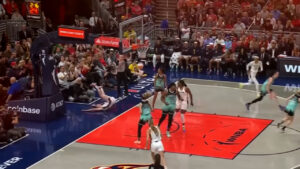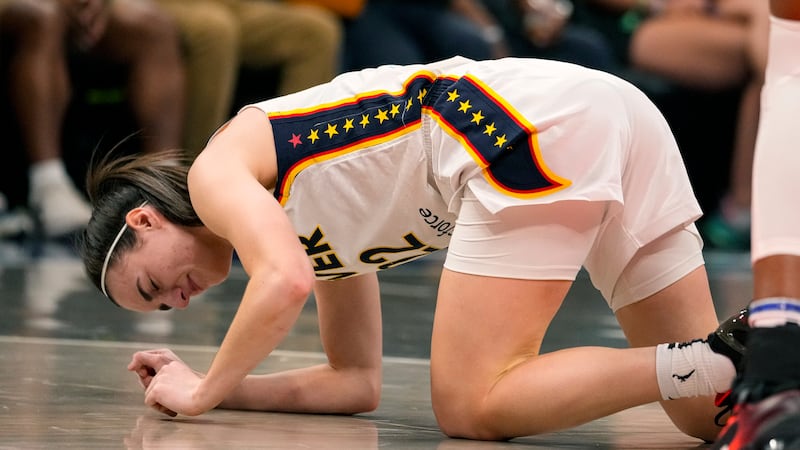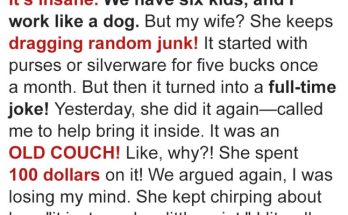On what should have been just another night of intense basketball, the WNBA changed forever.
Caitlin Clark—a rookie phenom, an icon in the making, and the face of a new generation of fans—had just crossed half-court during the third quarter of a high-stakes game between the Indiana Fever and the New York Liberty. The air was thick with tension. Every possession mattered. The arena buzzed with energy as Clark surged forward, cutting through defenders with her signature quickness.
But then—one step. One collision. And everything stopped.
Clark collapsed. The arena went silent.

What happened in the seconds that followed has since become the most scrutinized moment of the WNBA season. But it wasn’t just the injury that sparked outrage—it was what happened after. And what didn’t happen. A silence, not just in the arena, but from the referees, the league office, and for a while… everyone.
Until the video leaked.
The Play That Changed Everything
Let’s start with the facts. The Indiana Fever, struggling for momentum, were tied with the powerhouse Liberty in the final minutes of the third quarter. Clark, with 15 points already on the board, was pressing the lane. Sabrina Ionescu stepped up defensively. The moment they collided, it was clear something was wrong.
Clark didn’t bounce back up.
She clutched her knee, grimaced in pain, and didn’t even try to move. The medical staff rushed in. Her teammates surrounded her, some with hands over their mouths, others with fury on their faces. The Liberty players stood in stunned silence. Even Ionescu looked shaken.

Referees huddled. They watched a quick replay. And then… nothing. No foul. No flagrant. Not even a whistle for excessive contact.
The game resumed. The Liberty won.
But the mood in the arena had turned cold. Something didn’t sit right.
The Silence — Then the Leak
Hours later, social media erupted.
A fan’s courtside video—raw, uncut, and taken from a completely different angle—began circulating online. It clearly showed the play. The footage wasn’t blurry. It wasn’t speculative. It showed Ionescu stepping into Clark’s path, making forceful contact with her lead leg. Clark’s knee twisted awkwardly as she fell.
It was not a flop. It was not incidental. It was a dangerous, high-risk collision—and it hadn’t even drawn a whistle.
Within minutes, the clip went viral. Within hours, outrage began to swell.
The League Responds—Too Late?
By morning, #JusticeForClark was trending on X. Commentators from ESPN, fans from both camps, and even NBA stars weighed in.
The WNBA issued a statement late the next day:
“The safety of our players is our top priority. We are conducting a full review of the incident involving Caitlin Clark. Our thoughts are with her, and we are committed to ensuring accountability and fairness on the court.”
But that wasn’t enough to quell the storm.
Because by then, it had already leaked that one of the referees from that game had been quietly suspended pending internal review. The league hadn’t announced it. It was discovered through back channels—and that secrecy only made things worse.
Now, the question wasn’t just whether Clark had been fouled.
The question was whether the league had tried to cover it up.
A League Under Fire
The response from players was swift.
A’ja Wilson, Clark’s teammate and reigning MVP, tweeted bluntly:
“That wasn’t just ‘physical play.’ That was dangerous. We have a right to protection, just like anyone else.”
Brittney Griner commented, “You can’t talk about growing the league while letting stars get hurt like this.”
Even WNBA veterans like Sue Bird and Diana Taurasi, who had rarely weighed in on league officiating, expressed concern. “We’ve all had hard falls,” Taurasi said, “but you know when the whistle doesn’t blow because someone’s scared to call it? That’s when it’s a problem.”
Sabrina Ionescu, caught in the center of the controversy, eventually addressed the media.
“I didn’t mean to hurt anyone,” she said. “It was a heat-of-the-moment play. I’m not a dirty player. But I understand the criticism. I wish Caitlin a full and fast recovery.”


